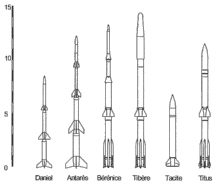|
Tibère  Tibère was a French atmospheric reentry test rocket developed by O.N.E.R.A. (Office National d'Etudes et de Recherches Aérospatiales).[1][2][3] It evolved from its predecessor, Bèrènice, with development initiated in 1965 to support the ELECTRE reentry experiment program.[1][4][3] Tibère, standing at a height of 14.5 m and weighing 4.5 tons, operated as a three-stage rocket.[2] DescriptionThe first stage comprised a SEPR-739-2 Stromboli, that, similar to Bèrènice and Titus, was encircled by four SEPR-P167 stabilization rockets.[1][2][4][3] This was followed by another SEPR-739-2 Stromboli for the second stage, and the third stage housed a P.064 inherited from Diamant A.[1][2][4][3] The firing of the initial two stages during ascent propelled the upper composite (3rd stage + payload) to reach an altitude of 150 km.[1] The Cassiopée attitude control system precisely oriented the composite before the P.064 motor accelerated it to high speed during descent from 130 to 60 km altitude.[1][3] The experiment itself occurred between 60 and 20 km, lasting ten seconds until the payload destruction.[1] LaunchesDespite the procurement of four Tibère units, only two flights were executed from Biscarrosse, occurring on February 23, 1971, and March 18, 1972.[1][2][3] Wikimedia Commons has media related to Tibère (sounding rocket). See alsoReferences
|